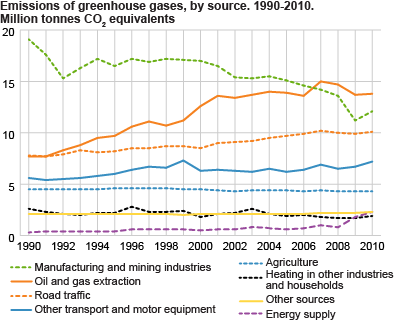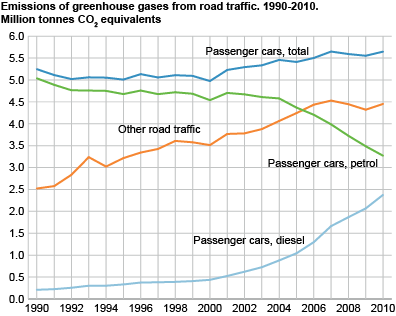Content
Published:
This is an archived release.
Increased greenhouse gas emissions in 2010
In 2010, the domestic greenhouse gas emissions amounted to 53.9 million tonnes of CO2 equivalents. This was 4.7 per cent more than in 2009. The large increase is mainly due to a rise in the activity in the Norwegian economy after the decline in 2008 and 2009.
Detailed figures on Norwegian greenhouse gas emissions in 1990-2010 have now been published. The statistics are compiled by Statistics Norway in collaboration with the Climate and Pollution Agency. The new calculations confirm the preliminary results presented in May 2011. The figures show a considerable rise in domestic emissions from 2009 to 2010.
CO2 the largest contributor
Eighty-four per cent of Norwegian greenhouse gas emissions in 2010 were CO2(carbon dioxide), which thus dominated the emissions. Emissions of CO2 have increased by more than 30 per cent from 1990, particularly due to larger emissions from extraction of gas and oil. Emissions of CO2 rose significantly in the period 1990-2007, while the economic decline caused an emission reduction in 2008 and 2009 before a new increase in 2010. The total greenhouse gas emissions in 2010 were somewhat higher than in 2008, but still 1.6 million tonnes of CO2 equivalents lower than in the peak year 2007.
|
This article discusses domestic emissions (emissions from Norwegian territory), net sinks in forest and emissions from international air and sea transport. |
| 2010 | Per cent change 1990-2010 | Per cent change 2009-2010 | |||||||||||||||||||||||||||||||||||||||||||||||||||||||||||||||||||||||||||||
|---|---|---|---|---|---|---|---|---|---|---|---|---|---|---|---|---|---|---|---|---|---|---|---|---|---|---|---|---|---|---|---|---|---|---|---|---|---|---|---|---|---|---|---|---|---|---|---|---|---|---|---|---|---|---|---|---|---|---|---|---|---|---|---|---|---|---|---|---|---|---|---|---|---|---|---|---|---|---|---|
| Emissions from Norwegian territory2 | 53.9 | 8.2 | 4.7 | ||||||||||||||||||||||||||||||||||||||||||||||||||||||||||||||||||||||||||||
| Oil and gas extraction3 and 7 | 13.8 | 78.1 | 0.9 | ||||||||||||||||||||||||||||||||||||||||||||||||||||||||||||||||||||||||||||
| Manufacturing and mining industries | 12.1 | -36.7 | 7.5 | ||||||||||||||||||||||||||||||||||||||||||||||||||||||||||||||||||||||||||||
| Energy supply7 | 2.3 | 619.6 | 30.4 | ||||||||||||||||||||||||||||||||||||||||||||||||||||||||||||||||||||||||||||
| Heating in other industries and households | 1.9 | -29.3 | 8.0 | ||||||||||||||||||||||||||||||||||||||||||||||||||||||||||||||||||||||||||||
| Road traffic4 | 10.1 | 30.0 | 2.3 | ||||||||||||||||||||||||||||||||||||||||||||||||||||||||||||||||||||||||||||
| Aviation, coastal traffic, fishing vessels, motor equipment4 | 7.2 | 27.2 | 7.5 | ||||||||||||||||||||||||||||||||||||||||||||||||||||||||||||||||||||||||||||
| Agriculture | 4.3 | -5.0 | 0.2 | ||||||||||||||||||||||||||||||||||||||||||||||||||||||||||||||||||||||||||||
| Other sources | 2.3 | 7.9 | 2.0 | ||||||||||||||||||||||||||||||||||||||||||||||||||||||||||||||||||||||||||||
| Sinks and emissions from forest and land areas in Norway5 | -25.3 | 196.0 | ... | ||||||||||||||||||||||||||||||||||||||||||||||||||||||||||||||||||||||||||||
| Emissions from international air and ocean transport8 | 12.0 | -15.7 | -7.4 | ||||||||||||||||||||||||||||||||||||||||||||||||||||||||||||||||||||||||||||
| International air transport | 1.5 | 141.5 | 20.3 | ||||||||||||||||||||||||||||||||||||||||||||||||||||||||||||||||||||||||||||
| International ocean transport6 | 10.5 | -22.9 | -10.4 | ||||||||||||||||||||||||||||||||||||||||||||||||||||||||||||||||||||||||||||
| 1 | Includes only known sources influenced by human activity. Sinks in water are not included. |
| 2 | Emissions comprised by the Kyoto protocol. |
| 3 | Including combustion and process emissions from offshore and onshore installations. |
| 4 | Includes transport for hire or reward and on own account in the different industries. |
| 5 | 2009 figure. Source: The Norwegian Forest and Landscape Institute. |
| 6 | Includes ships operated by shipping companies registered in Norway, regardless of ownership or flag state. |
| 7 | Figures for Oil and gas extraction and Energy supply were corrected 13 february 2012 at 11.45 am. |
| 8 | Figures for Per cent change 1990-2010 and 2009-2010 were corrected 13 february 2012 at 16.05 pm. |
| Source: Emission inventory from Statistics Norway and the Climate and Pollution Agency. | |
Altered ratio between emission sources from 1990
Since 2007, oil and gas activities have caused the largest greenhouse gas emissions in Norway. In 1990, however, emissions from manufacturing industries dominated - they were almost 2.5 times larger than emissions from oil and gas activities. From 1990 to 2010, emissions from manufacturing industries were reduced by a third, whereas emissions from oil and gas activities increased by two thirds. The reduction in emissions from manufacturing industries in the period from 1990 is due both to the closure of plants and technological improvements. The drop in emissions of nitrous oxide from production of fertiliser exemplifies the latter. Since 2005, these emissions have been reduced by more than 80 per cent due to the introduction of environmental technology. Technological improvements have also had a great bearing on emission reductions for PFCs and SF6. Emissions of PFCs from production of aluminium have been reduced by 3.2 million tonnes of CO2 equivalents from 1990. After a strong drop in emissions in CO2 from production of ferro alloys in 2009, caused by lower demand because of the financial crisis, these emissions had, in 2010, returned to the level in the years preceding 2009. Transport emissions are dominated by road traffic, which contributed to 19 per cent of the total domestic greenhouse gas emissions in 2010.
Growing emissions from energy supply from 2009
There has been a strong rise in emissions from energy supply since 2009. This is due to higher activity at the gas power plant at Kårstø from 2009 and the commissioning of the combined power and heating plant at Mongstad in 2010. These emissions stem from use of natural gas in electricity and heat production. Emissions from production of electricity have previously been small, as this sector has been dominated by hydroelectricity. Other energy supply consists mainly of district heating, where waste is the most important energy commodity.
Large heating emissions
The greenhouse gas emissions from heating in households rose by 18 per cent from 2009 to 2010. This was due to both high electricity prices in 2010 and the fact that 2010 was a cold year. The average temperature in Norway was 1 degree below normal, which makes 2010 the 10th coldest year since 1900. Compared with 1990, however, the households’ heating emissions were almost halved, due to the fact that electricity and district heating constitute a continually growing share of the heating.
Increasing emissions from road traffic
Greenhouse gas emissions from road traffic grew by 30 per cent from 1990 to 2010. After a decrease in 2008 and 2009, the emissions in 2010 were almost back on the level in the peak year 2007. Goods transport constitutes a growing share of the emissions from road traffic. Emissions from passenger cars and goods transport have grown by 8 and 76 per cent respectively since 1990.
The whole growth in emissions from passenger cars has taken place between 2001 and 2007. These emissions have, however, grown little compared with the growth in traffic. Factors that have contributed to this include more energy efficient vehicles, intermixture of bio fuels and a changeover from petrol to auto diesel. When comparing a diesel car and petrol car with the same size of engine, the diesel car has a lower emission level per driven kilometre.
The goods transport’s share of total emissions from road traffic increased from 32 per cent in 1990 to 43 per cent in 2010. The emissions per driven kilometre have increased with the shift towards the use of larger lorries, but at the same time the emissions per tonne of freighted goods have decreased.
Net sinks in forest
Since the 1920s, the cutting of Norwegian forests has been lower than the growth. This implies that Norway has larger sinks than emissions of CO2 in forest. According to calculations by the Norwegian Forest and Landscape Institute, net sinks of greenhouse gases from forest and areas in Norway amounted to approximately 25 million tonnes of CO2 in 2009. This is about half of the annual greenhouse gas emissions in CO2 equivalents.
Significant emissions from Norwegian ships abroad
Emissions from international sea transport have been estimated at approximately 10.5 million tonnes of CO2 equivalents in 2010. International sea transport is defined here as ships operated by shipping companies registered in Norway, regardless of ownership or flag state. Figures on emissions from international sea transport have been estimated on the basis of bunker costs, and must be regarded as uncertain.
International air traffic, i.e. Norwegian airlines’ traffic abroad, was responsible for approximately 1.5 million tonnes of CO2 equivalents in 2010. Emissions from this source have grown strongly in recent years - from 2004 they have more than doubled.
International obligations and national targets on emission cutsNorway’s allocated emission quota from the UN amounts to 50.1 million tonnes of CO2 equivalents annually in the period 2008-2012. This is 1 per cent more than the domestic emissions in 1990. The emissions in 2008-2010 exceed the allocated annual amount. Norway can, however, fulfil the obligation by using three flexibility mechanisms: Joint Implementation, the Clean Development Mechanism and quota trading. The emission inventory that is reported annually to the UN also includes emissions and sinks in forest and other land areas. According to the Kyoto Protocol, Norway has an annual entitlement to be credited with approximately 1.5 million tonnes from sinks in forests for the years 2008-2012. Norway’s policy, however, is that these sinks shall not be used to fulfil the Kyoto Protocol obligations. In 2008, the majority in the Norwegian parliament entered into an agreement on a national target for emission reductions. The target is that domestic emissions not shall exceed 45-47 million tonnes of CO2 equivalents in 2020. In 2010, the emissions were 7-9 million tonnes above this national target. |
About the emission statisticsRead more about: - documentation of the emission accounts - emission figures for nitrogen oxides, sulphur dioxide, ammonia, NMVOC and carbon monoxide - emission figures for hazardous substances and particulate matter |
Tables:
- Table 1 Emissions to air by source. 1990
- Table 2 Emissions to air by source. 2009
- Table 3 Emissions to air by source. 2010*
- Table 4 Emissions to air of greenhouse gases. 1980-2010*
- Table 5 Emissions to air of greenhouse gases by industry. 1990, 2009 and 2010*. 1 000 tonnes CO2 equivalents. Change in per cent
Contact
-
Trude Melby Bothner
E-mail: trude.melby.bothner@ssb.no
tel.: (+47) 40 81 14 25
-
Berit Storbråten
E-mail: berit.storbraten@ssb.no
tel.: (+47) 40 81 14 23


